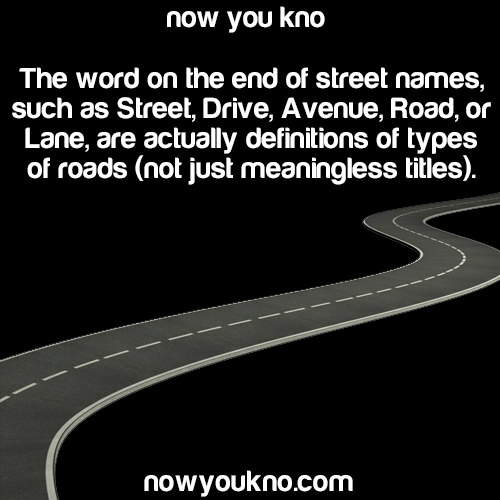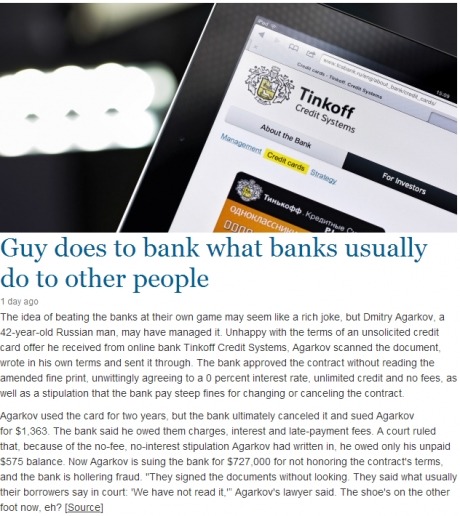Congratulations To Remington Richardson DDS, Chad Hannibal DDS, Tyler Thompson DDS, Taylor Sims DDS,

Congratulations to Remington Richardson DDS, Chad Hannibal DDS, Tyler Thompson DDS, Taylor Sims DDS, and Demont Davis DDS.
More Posts from Solarpiracy and Others

Source for more facts follow NowYouKno
A road has no special qualifiers. It connects point a to point b.
A street connects buildings together, usually in a city, usually east to west, opposite of avenue.
An avenue runs north south. Avenues and streets may be used interchangeably for directions, usually has median
A boulevard is a street with trees down the middle or on both sides
A lane is a narrow street usually lacking a median.
A drive is a private, winding road
A way is a small out of the way road
a court usually ends in a cul de sac or similar little loop
a plaza or square is usually a wide open space, but in modern definitons, one of the above probably fits better for a plaza as a road.
a terrace is a raised flat area around a building. When used for a road it probably better fits one of the above.
uk, a close is similar to a court, a short road serving a few houses, may have cul de sac
run is usually located near a stream or other small body of water
place is similar to a court, or close, usually a short skinny dead end road, with or without cul de sac, sometimes p shaped
bay is a small road where both ends link to the same connecting road
crescent is a windy s like shape, or just a crescent shape, for the record, above definition of bay was also given to me for crescent
a trail is usually in or near a wooded area
mews is an old british way of saying row of stables, more modernly seperate houses surrounding a courtyard
a highway is a major public road, usually connecting multiple cities
a motorway is similar to a highway, with the term more common in New Zealand, the UK, and Austrailia, no stopping, no pedestrian or animal traffic allowed
an interstate is a highway system connecting usually connecting multiple states, although some exist with no connections
a turnpike is part of a highway, and usully has a toll, often located close to a city or commercial are
a freeway is part of a highway with 2 or more lanes on each side, no tolls, sometimes termedexpressway, no intersections or cross streets.
a parkway is a major public road, usually decorated, sometimes part of a highway, has traffic lights.
a causeway combines roads and bridges, usually to cross a body of water
circuit and speedway are used interchangeably, usually refers to a racing course, practically probably something above.
as the name implies, garden is usually a well decorated small road, but probably better fits an above
a view is usually on a raised area of land, a hill or something similar.
byway is a minor road, usually a bit out of the way and not following main roads.
a cove is a narrow road, can be sheltered, usually near a larger body of water or mountains
a row is a street with a continuous line of close together houses on one or both sides, usually serving a specific function like a frat
a beltway is a highway surrounding an urban area
quay is a concrete platform running along water
crossing is where two roads meet
alley a narrow path or road between buildings, sometimes connects streets, not always driveable
point usually dead ends at a hill
pike usually a toll road
esplanade long open, level area, usually a walking path near the ocean
square open area where multiple streets meet, guess how its usually shaped.
landing usually near a dock or port, historically where boats drop goods.
walk historically a walking path or sidewalk, probably became a road later in its history
grove thickly sheltered by trees
copse a small grove
driveway almost always private, short, leading to a single residence or a few related ones
laneway uncommon, usually down a country road, itself a public road leading to multiple private driveways.
trace beaten path
circle usually circles around an area, but sometimes is like a “square”, an open place intersected by multiple roads.
channel usually near a water channel, the water itself connecting two larger bodies of water,
grange historically would have been a farmhouse or collection of houses on a farm, the road probably runs through what used to be a farm
park originally meaning an enclosed space, came to refer to an enclosed area of nature in a city, usually a well decorated road.
mill probably near an old flour mill or other mill.
spur similar to a byway, a smaller road branching off from a major road.
bypass passes around a populated area to divert traffic
roundabout or traffic circle circle around a traffic island with multiple connecting routes, a roundabout is usually smaller, with less room for crossing and passing, and safer
wynd a narrow lane between houses, similar to an alley, more common in UK
drive shortened form of driveway, not a driveway itself, usually in a neighborhood, connects several houses
parade wider than average road historically used as a parade ground.
terrace more common in uk, a row of houses.
chase on land historically used as private hunting grounds.
branch divides a road or area into multiple subdivisions.

Christopher Gray, 21, a Drexel University junior and CEO/Founder of Scholly, has found a way to make finding those scholarships easier.
Gray himself has been very successful in finding scholarship funds. He is known as the “Million-Dollar Scholar” after being awarded $1.3 million in scholarships.
Over the past three years, Gray has also helped other families manually scour through databases, and figured, “Hey, I need something that can help. There has to be a faster way.”
Gray developed the answer in the form of Scholly, an app that uses eight specific parameters, like state, GPA, or race, to instantly filter through a deep directory of scholarships available for the prospective student.
“It’s extremely simple,” says Gray and that ultimately was the goal.
“The fact that it’s on the mobile (phone) really hits the audience,” says Soham Bhonsle, 21, a Scholly user and Drexel University senior. “It serves the need of its time. We want it on the go.”
Nicholas Pirollo, chief technological officer for Scholly, also offers that apps optimize searches compared to standard websites because they are more tailored to specific needs.
A recent study, conducted by Sallie Mae, shows that 39% of families used scholarship funds to pay for college during the 2012-2013 academic year and Scholly connects users with relevant scholarships in about five minutes. Scholly’s database is updated monthly to remove scholarships that are no longer available, add scholarships, and refresh deadlines.
There is money out there to go to school. Scholly has more than 10,000 downloads of the $0.99 app found in the Apple App Store and Google Play.
Scholly’s costs are intentionally positioned at an affordable price to serve more people that need it and boast a potential big payoff.
“Pay 99 cents and you may get $5,000 or $6,000 in scholarships.”
Scholly helps put the power of funding your education in your hands.


x

via
my economics professor mentioned that my state's old growth logging ban was lifted (in a positive tone) and i already didn't like her but i almost went apeshit istg. @headspace-hotel's posts actually changed my brain chemistry. i rambled to a few classmates about them afterwards and went into a research spiral for half the afternoon too. i'm so angry that i'll never see them. i'll never be able to walk on six inches of topsoil. i'll be lucky to walk on one. economics are a joke i want my goddamn earth back





The #1400challenge - How to turn stimulus checks into collective power | Inhabit
The last year has demonstrated just how razor thin our margin of survival is—from the brutality of the police to the viciousness of the virus, from the absurd ups-and-downs of the economy to the glaring incompetence of the government.
Now that they’ve been forced to send some cash our way, we’d like to propose a little something they maybe didn’t expect. The idea is simple: what if we took our stimulus checks and put them towards collective use?
In recent weeks Inhabit has been collaborating with groups around the country to put together a series of kits called the #1400challenge. The result is a handful of introductory guides for a variety of collective projects—from soundsystems and meshnets to pop-up dwellings and community gyms.
Each project is based on a proven and replicable idea, a working model that has already seen action in the streets and in neighborhoods. And each could be a jumping off point for new designs, new skillsets, new encounters, and newly expanded frontlines in the battle for the future.
No doubt many of us will have to spend our checks on necessities like groceries, rent, medical bills—all the bullshit it takes to stay alive in this bullshit world. But for those who can, and especially for those who want to pool resources, the opportunity is clear: invest in collective infrastructure that increases our shared capabilities, that augments our ability to live and to fight.
Here’s our wager. We have to translate isolated, temporary solutions to individual problems into the material and ethical basis for building collective power. We need autonomous solutions that scale at the level of neighborhoods, cities, and regions. Our power together unlocks more potential than we have alone.
It’ll take more than a stuck container ship to break the hold of the economy over our lives. Design and build new ways of living together, that lessen our dependence on their system at the same time that we cultivate trust in one another. Leverage all the means at our disposal—including their cold hard cash—to bring out the beauty, dignity, and creativity of our shared existence.
Read more…
If you want even more ideas, check out my #practical tag
dealing with the worst case scenario
your condom breaks
you feel a lump on your breast
your friends are ignoring you
you’re stranded on an island
you got rejected by a crush
you get into a car accident
you got stung by a bee/wasp
you got fired from your job
you’re in an earthquake
your tattoo gets infected
your house is on fire
you’re lost in the woods
you get arrested abroad
you get robbed
your partner cheated on you
you’re on a ship that’s sinking
you fall into ice
you’re stuck in an elevator
you hit a deer with your car
you have food poisoning
your pet passed away
you fall off of a horse
you or your friend has alcohol poisoning
you have toxic shock syndrome
your house has a gas leak





The #1400challenge - How to turn stimulus checks into collective power | Inhabit
The last year has demonstrated just how razor thin our margin of survival is—from the brutality of the police to the viciousness of the virus, from the absurd ups-and-downs of the economy to the glaring incompetence of the government.
Now that they’ve been forced to send some cash our way, we’d like to propose a little something they maybe didn’t expect. The idea is simple: what if we took our stimulus checks and put them towards collective use?
In recent weeks Inhabit has been collaborating with groups around the country to put together a series of kits called the #1400challenge. The result is a handful of introductory guides for a variety of collective projects—from soundsystems and meshnets to pop-up dwellings and community gyms.
Each project is based on a proven and replicable idea, a working model that has already seen action in the streets and in neighborhoods. And each could be a jumping off point for new designs, new skillsets, new encounters, and newly expanded frontlines in the battle for the future.
No doubt many of us will have to spend our checks on necessities like groceries, rent, medical bills—all the bullshit it takes to stay alive in this bullshit world. But for those who can, and especially for those who want to pool resources, the opportunity is clear: invest in collective infrastructure that increases our shared capabilities, that augments our ability to live and to fight.
Here’s our wager. We have to translate isolated, temporary solutions to individual problems into the material and ethical basis for building collective power. We need autonomous solutions that scale at the level of neighborhoods, cities, and regions. Our power together unlocks more potential than we have alone.
It’ll take more than a stuck container ship to break the hold of the economy over our lives. Design and build new ways of living together, that lessen our dependence on their system at the same time that we cultivate trust in one another. Leverage all the means at our disposal—including their cold hard cash—to bring out the beauty, dignity, and creativity of our shared existence.
Read more…
If you want even more ideas, check out my #practical tag


Learn Stuff! // LINK
Fascinated by the number of dog people who hate wild canines and flat up think they are evil. You would think way more people would love coyotes and African wild dogs and (not actual canines but certainly dog like) hyenas.
-
 ldt123stuff liked this · 1 month ago
ldt123stuff liked this · 1 month ago -
 myscorpiosworld-blog liked this · 2 years ago
myscorpiosworld-blog liked this · 2 years ago -
 stickyeaglepeachweasel liked this · 2 years ago
stickyeaglepeachweasel liked this · 2 years ago -
 itsveezy reblogged this · 2 years ago
itsveezy reblogged this · 2 years ago -
 itsveezy liked this · 2 years ago
itsveezy liked this · 2 years ago -
 afrogenix liked this · 2 years ago
afrogenix liked this · 2 years ago -
 lamefoever liked this · 2 years ago
lamefoever liked this · 2 years ago -
 leastfavmutual reblogged this · 2 years ago
leastfavmutual reblogged this · 2 years ago -
 just-whitney reblogged this · 2 years ago
just-whitney reblogged this · 2 years ago -
 newyawkslice liked this · 2 years ago
newyawkslice liked this · 2 years ago -
 haitiansmurf reblogged this · 2 years ago
haitiansmurf reblogged this · 2 years ago -
 haitiansmurf liked this · 2 years ago
haitiansmurf liked this · 2 years ago -
 avejuicekari liked this · 2 years ago
avejuicekari liked this · 2 years ago -
 plumpyxxxavier liked this · 2 years ago
plumpyxxxavier liked this · 2 years ago -
 pixelhotsauce reblogged this · 2 years ago
pixelhotsauce reblogged this · 2 years ago -
 pixelhotsauce liked this · 2 years ago
pixelhotsauce liked this · 2 years ago -
 itsexclusive2 reblogged this · 2 years ago
itsexclusive2 reblogged this · 2 years ago -
 bigbromelvin reblogged this · 2 years ago
bigbromelvin reblogged this · 2 years ago -
 crash1233 liked this · 2 years ago
crash1233 liked this · 2 years ago -
 troubleman148 reblogged this · 2 years ago
troubleman148 reblogged this · 2 years ago -
 troubleman148 liked this · 2 years ago
troubleman148 liked this · 2 years ago -
 blackprograms liked this · 2 years ago
blackprograms liked this · 2 years ago -
 uncleboogie69 liked this · 2 years ago
uncleboogie69 liked this · 2 years ago -
 unclerik77-blog reblogged this · 2 years ago
unclerik77-blog reblogged this · 2 years ago -
 unclerik77-blog liked this · 2 years ago
unclerik77-blog liked this · 2 years ago -
 famoustrashempathhero liked this · 3 years ago
famoustrashempathhero liked this · 3 years ago -
 mandreamingbooty liked this · 3 years ago
mandreamingbooty liked this · 3 years ago -
 msmitty1952 liked this · 3 years ago
msmitty1952 liked this · 3 years ago -
 drezuus liked this · 3 years ago
drezuus liked this · 3 years ago -
 amazonbrown liked this · 3 years ago
amazonbrown liked this · 3 years ago -
 talldread reblogged this · 3 years ago
talldread reblogged this · 3 years ago -
 talldread liked this · 3 years ago
talldread liked this · 3 years ago -
 pruittjdog69 liked this · 3 years ago
pruittjdog69 liked this · 3 years ago -
 mabelaugusta liked this · 3 years ago
mabelaugusta liked this · 3 years ago -
 mrdlwilliams reblogged this · 3 years ago
mrdlwilliams reblogged this · 3 years ago -
 surrealhypebeast liked this · 3 years ago
surrealhypebeast liked this · 3 years ago -
 fuck-onme reblogged this · 3 years ago
fuck-onme reblogged this · 3 years ago -
 moonchildbritt reblogged this · 3 years ago
moonchildbritt reblogged this · 3 years ago

a repository of information, tools, civil disobedience, gardening to feed your neighbors, as well as punk-aesthetics. the revolution is an unending task: joyous, broken, and sublime
211 posts